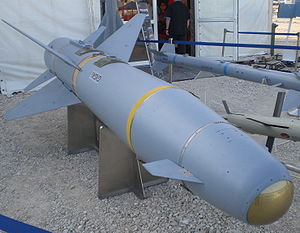Popeye (missile)
| Popeye | |
|---|---|

The "Popeye" standoff missile
|
|
| Type | Air-to-surface missile |
| Place of origin | Israel |
| Service history | |
| In service | 1985–present |
| Used by | See Users |
| Production history | |
| Designer | Rafael Advanced Defense Systems |
| Manufacturer | Rafael Advanced Defense Systems Lockheed Martin Turkish Aerospace Industries |
| Specifications | |
| Weight | 1,360 kg (3,000 lb) |
| Length | 4.82 m (15 ft 10 in) |
| Diameter | 533 mm (21 in) |
| Warhead | 340 kg (750 lb) blast fragmentation or 360 kg (800 lb) I-800 penetrating |
|
|
|
| Engine | Single-stage Solid-fuel rocket |
| Wingspan | 198 cm (78 in) |
|
Operational
range |
78 km (48 miles) |
|
Guidance
system |
Inertial plus IIR or TV |
|
Launch
platform |
Fixed-wing aircraft, Dolphin class submarine (Popeye Turbo SLCM) |
Popeye is the name of a family of air-to-surface missiles developed and in use by Israel, of which several types have been developed for Israeli and export users. A long-range submarine-launched cruise missile variant of the Popeye Turbo has been speculated as being employed in Israel's submarine-based nuclear forces. The United States operates the Popeye under a different designation according to US naming conventions as the AGM-142 Have Nap.
The Popeye is designed for precision attack against large targets from stand off ranges. The standard Popeye and smaller Popeye-Lite are powered by a single-stage solid rocket. Rafael offered a Popeye Turbo air launched variant featuring a jet engine and folding wings for a UK competition specifying a cruise missile with range of at least 320 km (200 miles) in 1994; publicly exposing a lowest possible maximum range for that variant. An inertial guidance system pilots the missile towards the target; for terminal homing the pilot can control the missile directly via an INS and data link, aiming via either a television or imaging infrared seeker depending on the missile model. It is not necessary for the launching aircraft to direct the missile—control can be passed to another platform while the firing aircraft escapes the area. There are two choices of warhead for the export versions, a 340 kg (750 lb) blast/fragmentation or 360 kg (800 lb) penetrator.
The alleged Israeli submarine-launched cruise missile variant is reported to be jet powered and nuclear armed with a greatly increased range, though according to the Federation of American Scientists "open literature provides little information on this system" but in a May 2000 test launch was tracked for 1500 km.
Popeye Turbo SLCM—A reportedly stretched version of the Popeye Turbo developed for use as a submarine-launched cruise missile (SLCM) was widely reported in a US Navy observed 2002 test in the Indian Ocean to have hit a target at 1500 km. It can allegedly carry a 200 kt nuclear warhead. It is believed that the stretched Popeye Turbo is the primary strategic second strike nuclear deterrent weapon that can be fired from the 650 mm secondary torpedo tubes of the Israeli Dolphin-class submarines. It is believed that the SLCM version of the Popeye was developed by Israel after the US Clinton administration refused an Israeli request in 2000 to purchase Tomahawk long range SLCM's because of international MTCR proliferation rules. While the standard Popeye is 533 mm the Dolphin class submarines have four 650 mm torpedo tubes in addition to the six standard 533 mm tubes allowing for the possibility that a SLCM Popeye derivative may be a larger diameter.
...
Wikipedia
